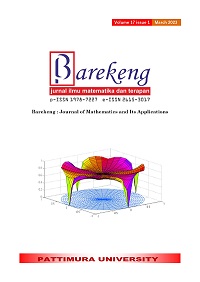QUANTILE REGRESSION MODEL ON RAINFALL IN MAKASSAR 2019
Abstract
Makassar is an area that has a monsoon rainfall pattern. This study aims to find a quantile regression model and to determine the factors that significantly influence rainfall in the city of Makassar. This applied research applies a quantile regression model to rainfall data which is seasonal data. The advantage of this quantile regression model is that it is able to detect extreme conditions of rainfall, such as heavy rain. The data used is daily data in 2019. The estimation results obtained 9 (nine) models from each quantile used. The best model is obtained based on the largest coefficient of determination ( ), namely the 0,8th quantile ( ) of 0.28%. Furthermore, based on the model, it is found that the factor that significantly influences rainfall in the city of Makassar is humidity. At the same time, the air temperature and wind speed have no significant effect on rainfall in the city of Makassar.
Downloads
References
Sukarna, E. Y. P. Ananda, and M. S. Wahyuni, “Rainfall Forecasting Model Using ARIMA and Kalman Filter in Makassar, Indonesia,” J. Phys. Conf. Ser., vol. 2123, no. 1, pp. 0–7, 2021, doi: 10.1088/1742-6596/2123/1/012044.
S. A. Thamrin, Aswi, Ansariadi, A. K. Jaya, and K. Mengersen, “Bayesian spatial survival modelling for dengue fever in Makassar, Indonesia,” Gac. Sanit., vol. 35, no. S1, pp. S59–S63, 2021, doi: 10.1016/j.gaceta.2020.12.017.
A. Aswi, S. Cramb, W. Hu, G. White, and K. Mengersen, “Spatio-Temporal Analysis of Dengue Fever in Makassar Indonesia: A Comparison of Models Based on CARBayes,” in Case Studies in Applied Bayesian Data Science, Lecture Notes in Mathematics, vol. 2259, Switzerland: Springer Nature Switzerland AG, 2020, pp. 229–244.
Paida, “Deteksi Perubahan Pola Curah Hujan Kota Makassar,” Universitas Hasanuddin, 2011.
C. R. Malino, M. Arsyad, and P. Palloan, “Analisis parameter curah hujan dan suhu udara dikota Makassar terkait fenomena perubahan iklim,” J. Sains dan Pendidik. Fis., vol. 17, no. 2, pp. 139–145, 2021, [Online]. Available: http://ojs.unm.ac.id/jsdpf.
F. Mazid, Wasilah, and Alfiah, “Pusat Pelatihan Bulutangkis dengan Pendekatan Arsitektur Bioklimatik di Kota Makassar,” TIMPALAJA Archit. Student Journals, vol. 3, no. 2, pp. 143–152, 2021, [Online]. Available: https://journal.uin-alauddin.ac.id/index.php/timpalaja/article/view/18635/13110.
R. Maru et al., “Analysis of The Heat Island Phenomenon in Makassar, South Sulawesi, Indonesia,” Am. J. Appl. Sci., vol. 12, no. 11, 2015, doi: 10.3844/ajassp.2015.
W. Sanusi, “Analisis Homogenitas Data Curah Hujan Tahunan Kota Makassar,” J. Sci. Pinisi, vol. 2, no. 2, pp. 137–142, 2016.
S. Maulidani S, N. Ihsan, and Sulistiawaty, “Analisis Pola dan Intensitas Curah Hujan Berdasakan Data Observasi dan Satelit Tropical Rainfall Measuring Missions (TRMM) 3B42 V7 di Makassar,” J. Sains Dan Pendidik. Fis., vol. 11, no. 1, pp. 98–103, 2015.
D. N. Gujarati and D. C. Porter, Basic Econometrics, Fifth edit. New York: Douglas Reiner, 2009.
N. Fadhilah, E. Erfiani, and I. Indahwati, “Comparison of Functional Regression and Functional Principal Component Regression for Estimating Non-Invasive Blood Glucose Level,” Indones. J. Stat. Its Appl., vol. 5, no. 1, pp. 14–25, 2021, doi: 10.29244/ijsa.v5i1p14-25.
Saidah, F. Yanuar, and D. Devianto, “Analisis Regresi Kuantil,” J. Mat. UNAND, vol. 5, no. 1, p. 103, 2016, doi: 10.25077/jmu.5.1.103-107.2016.
V. E. Wahyudi and I. Zain, “Analisis ipm di pulau jawa menggunakan analisis regresi kuantil 1 1,2,” vol. 2, no. 1, 2014.
R. Rahmawati, Widiarti, and P. Novianti, “Regresi Kuantil (Studi Kasus pada Data Suhu Harian),” pp. 1–8, 2011.
A. Djuraidah and A. H. Wigena, “Regresi Kuantil untuk Eksplorasi Pola Curah Hujan di Kabupaten Indramayu Regression for Exploring Rainfall Pattern in Indramayu Regency,” J. ILMU DASAR, vol. 12, pp. 50–56, 2009.
Cintiani, “Pemodelan Regresi Kuantil (Studi Kasus Pengeluaran Rumah Tangga untuk Konsumsi Rokok),” Institut Teknologi Sepuluh November, 2017.
Harinaldi, Prinsip-Prinsip Statistik Untuk Teknik dan Sains. Jakarta: Erlangga, 2005.
N. Astari, Amran, and A. K. Jaya, “Pengujian Hipotesis pada Regresi Kuantil,” Universitas Hasanuddin, 2017.
N. Sinurat, Sugianto, and W. Harjupa, “Analisa Arah Angin menggunakan Equatorial Atmosphere Radar (EAR) dan Optical Rain Gauge (ORG) di Atas Kototabang Sumatera Barat,” Universitas Riau, 2016.
R. S. Sari and I. N. Budiantara, “Pemodelan Pengangguran Terbuka di Jawa Timur dengan Menggunakan Pendekatan Regresi Spline Multivariabel,” J. Sains Dan Seni Its, vol. 1, no. 1, pp. 236–241, 2012.
Copyright (c) 2023 Wahidah Sanusi, sukarna sukarna, Nur Harisahani

This work is licensed under a Creative Commons Attribution-ShareAlike 4.0 International License.
Authors who publish with this Journal agree to the following terms:
- Author retain copyright and grant the journal right of first publication with the work simultaneously licensed under a creative commons attribution license that allow others to share the work within an acknowledgement of the work’s authorship and initial publication of this journal.
- Authors are able to enter into separate, additional contractual arrangement for the non-exclusive distribution of the journal’s published version of the work (e.g. acknowledgement of its initial publication in this journal).
- Authors are permitted and encouraged to post their work online (e.g. in institutional repositories or on their websites) prior to and during the submission process, as it can lead to productive exchanges, as well as earlier and greater citation of published works.






1.gif)



